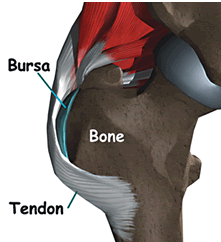Bursitis
Pain Management
May be the Key!
Daniel Sipple, DO, DABPM
Pain Management
Pain Clinic of Northwestern Wisconsin
Eau Claire
Is sleeping on your side becoming a bear because of pain in your hip? Do you not load up your tool belt because it hurts to rub against your hip? Is your shoulder not calming down after a long week on the job, the weekend softball tournament or a round of golf? Just started up running again and noticing your hips are sore? Has the usual soreness after gone on for an unusual amount of time? It’s possible you may be living with a condition known as bursitis. Bursitis is caused by swelling of the bursae. But what exactly is a bursae?
“A bursae is like your body’s version of a ball bearing. It lubricates friction between tendons, bones and ligaments throughout the body.”
A bursae is like your body’s version of a ball bearing. It lubricates friction between tendons, bones and ligaments throughout the body. As with a ball bearing, it does not work as well when it is overused and often times can become a source of pain. As with many aches and pains, a little time, rest and perhaps some oral anti-inflammatories often significantly help the condition, but when symptoms persist, it may be reasonable to consider discussing your condition with a physician for alternative treatment considerations.
Bursae are sac-like structures that secrete fluid, call synovial fluid, to fill the sac. The synovial fluid works like a sort of mini waterbed, and enables the bursae to lubricate joints and tendons it lives near. When the bursae are overworked, they can become swollen, tender and painful. Two common examples of bursitis are the bursae that reside in the shoulder, along with the bursae that reside on the lateral aspect of the hip.
 The shoulder or subdeltoid bursae helps to lubricate the muscles of the rotator cuff from the bone that overlies it. The subdeltoid bursae can become inflamed, particularly with activities such as repetitive throwing in baseball or softball, swinging a golf club or working with hand held tools, especially working overhead. As the shoulder moves overhead repetitively, time and again, the bursae, in protecting the rotator cuff, can become inflamed. Pain and tenderness are most often at the tip of the shoulder, but this can also radiate a little way down the arm. If you have persistent pain in your shoulder that does not improve with rest and over-the-counter medications, you may have bursitis.
The shoulder or subdeltoid bursae helps to lubricate the muscles of the rotator cuff from the bone that overlies it. The subdeltoid bursae can become inflamed, particularly with activities such as repetitive throwing in baseball or softball, swinging a golf club or working with hand held tools, especially working overhead. As the shoulder moves overhead repetitively, time and again, the bursae, in protecting the rotator cuff, can become inflamed. Pain and tenderness are most often at the tip of the shoulder, but this can also radiate a little way down the arm. If you have persistent pain in your shoulder that does not improve with rest and over-the-counter medications, you may have bursitis.
Patients often report pain over the side of the hip, particularly when they are trying to sleep at night. They can sleep on one side comfortably, but not on another side for any reasonable length of time, often waking up to reposition. This may represent irritation of the bursae over the side of the hip, known as the greater trochanteric bursae. Long distance cyclists and runners are another group that have pain in this region. In attempting to lubricate the muscles over the hip from the bone, the bursae can become overworked. When this happens, there is often tenderness over the lateral hip that sometimes radiates down the thigh. While this is a common cause of pain in the area, it may not be the only cause. Cortisone injections into the trochanteric bursae can both help alleviate pain and identify the source of the pain. In certain circumstances, the use of ultrasound or fluoroscopy is appropriate to ensure precise delivery of medication.
While overuse is the most common cause of bursitis, persons with rheumatologic conditions often experience them. For such patients, it is not only important to treat the bursitis, but to treat the rheumatologic condition. Samples of the fluid within the bursae may need to be taken to help identify these conditions. Less commonly, bursae can be infected, in which case antibiotic therapy may be warranted.
When pain persists despite judicious use of rest, ice and over-the-counter anti-inflammatory medication, patients often consult with a physician who can offer alternative treatment options. Physical therapy can strengthen the surrounding musculature, alleviating pressure over a bursae and reducing mechanical irritation. Tendon straps may also assist with reducing irritation to the bursae, improving pain and function. Prescription strength anti-inflammatories, prescribed by your physician, come in cream and patch forms. They can be placed directly over the area of pain and in some patients can provide hours worth of relief without having to take a medication by mouth. Cortisone injections can provide months of relief and are commonly performed for persistent bursitis.
A new development now available at the Pain Clinic of Northwestern Wisconsin for the treatment of bursitis is the use of ultrasound. Today’s ultrasonography allows precise visualization of tendons and is ideal for the diagnosis of and treatment of a variety of soft tissue disorders, including bursitis. Ultrasonic guidance provided by the physicians at the Pain Clinic can precisely target bursae for cortisone injections and provides peace of mind that the precise anatomical target is treated. For patients who do not respond to more conservative treatment, an injection of cortisone into bursae, precision guided under ultrasound, may be appropriate.
Dr. Sipple – Pain Clinic of Northwestern Wisconsin
For information or to schedule an appointment:
715-552-5346 | www.painclinic-nw.com
Dr. Sipple sees patients in Eau Claire and Rice Lake.